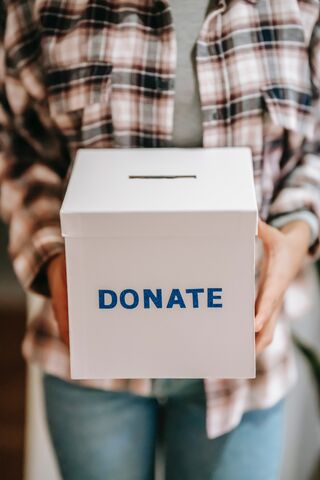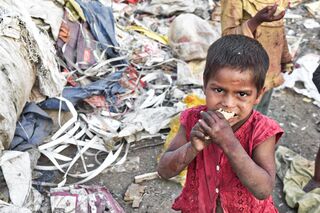Empathy
4 Reasons We Give to Charity
Giving can be motivated by empathy, the positive impact, and protecting others.
Posted May 10, 2022 Reviewed by Abigail Fagan
Key points
- Giving to charity has benefits for the donor as well as the beneficiaries.
- The desire to make a difference can make people favour appeals focused on smaller, solvable problems.
- Causes like climate change that seem distant in time are often overlooked, but health research is generally a popular charitable cause.
Think back to the last time you donated to a good cause. What motivated you? What about the last time there was an opportunity to donate but you chose not to? Researchers are trying to understand decisions to give and the factors which make us more likely to be generous to others. By revealing why people help others, we hope to maximise the benefits that both donors and beneficiaries gain from charitable giving.

The need for an evidence-based understanding is particularly acute given the pressing global challenges around the world. Appeals for donations towards critical causes, such as the war in Ukraine and limits to freedom for women and girls in Afghanistan, are recent examples where donating can make a big difference.
Some interesting insights into what motivates people to give come from the recent YouGov survey in the UK on what happened to prompt a donation. Of the people who were prompted by a person or appeal, the most common way that they were asked was by a friend or family member, highlighting the important role of our social networks in our charitable giving. However, 33% of people were not prompted by any person or communication from a charity, so what might have motivated them to donate and why do they sometimes say yes rather than no when asked?
1. We value positive outcomes for others
A key reason we donate to charity is to improve things for others, including other humans as well as non-human animals. This might sound obvious, but the idea that good things happening to others can also make us feel good goes against a lot of traditional ideas in economics that humans are generally selfish and should only be motivated by their own monetary gains.
More recently, research has found that giving money away makes the donor happy. Evidence that we experience positive outcomes for another person as a good thing too also comes from the fact that people can learn to pick the best of two random symbols in an experiment to increase the payment to someone else. Interestingly in the YouGov research and other studies, older people were more likely to donate than young people and our research has shown that older adults learn particularly well when helping someone else – a charitable outcome eliminates the decline in learning ability that usually occurs in later life.
2. To have a positive impact
A subtly different motivation from simply wanting good things for other people is the benefit we get from feeling responsible for that positive impact. In the same way that we enjoy achieving something in any aspect of our own lives, making a difference for someone else via a charity can be a strong motivation.
Charities can help boost this motivation by telling supporters about the specific impact that their donation will have, both when asking for donations and after a donation has been made. Knowing about the specific positive impact we can have is one possible reason why appeals focusing on an individual person are so powerful. These help us think about one small part of a big problem that we can solve by donating, rather than being overwhelmed by how many people need help.
3. To stop negative experiences

While donating to charity can cause positive emotions for both the person giving and the people benefitting from the donation, experiencing negative emotions when we know someone is suffering – known as empathy – can prompt us to help in the first place. Images and news of people experiencing war, natural disasters, disease, or hunger motivate us to relieve that suffering.
Research also shows we can find it easier to empathise with someone when they are similar to us or perceived as part of our “ingroup” rather than an “outgroup.” Ingroups and outgroups are often defined by characteristics such as race or nationality, which can lead to biases in who we help. However, we can also find similarities with people from very different groups, particularly if they are going through something we have also experienced, either directly or through someone we know. This could be one reason for donating during the pandemic, as many people were experiencing similar difficulties. Shared feelings across the UK of gratitude for the NHS, where staff were reducing and preventing so much suffering, helped appeals like the fundraising of Captain Tom be so successful.
4. To protect people from harm in future
Another finding from the YouGov survey was that the three most widely supported charities were health-related causes. This could partly be linked to motivation #3 above, as millions of people are already suffering due to cancer, heart problems and many other conditions. Another potential motivation is to find cures for medical conditions or eliminate them entirely, to prevent suffering in the future.
The idea that people donate to protect others from harm in the future could also apply to climate change or environmental charities. However, research also shows that humans value outcomes less when they occur in the future, a phenomenon known as temporal discounting. This presents a challenge for motivating people to donate towards longer-term goals and encourages people to donate to events happening now. To overcome this, it’s important to acknowledge the negative effects climate change is already having and see both future generations and our future selves as similar to our current selves, to ensure positive outcomes in the long term.
References
Avenanti, A., Sirigu, A., & Aglioti, S. M. (2010). Racial Bias Reduces Empathic Sensorimotor Resonance with Other-Race Pain. Current Biology, 20(11), 1018–1022. https://doi.org/10.1016/j.cub.2010.03.071
Bos, W. V. D., & McClure, S. M. (2013). Towards a general model of temporal discounting. Journal of the Experimental Analysis of Behavior, 99(1), 58–73. https://doi.org/10.1002/jeab.6
Curry, O. S., Rowland, L. A., Van Lissa, C. J., Zlotowitz, S., McAlaney, J., & Whitehouse, H. (2018). Happy to help? A systematic review and meta-analysis of the effects of performing acts of kindness on the well-being of the actor. Journal of Experimental Social Psychology, 76(May 2017), 320–329. https://doi.org/10.1016/j.jesp.2018.02.014
Cutler, J., Wittmann, M. K., Abdurahman, A., Hargitai, L. D., Drew, D., Husain, M., & Lockwood, P. L. (2021). Ageing is associated with disrupted reinforcement learning whilst learning to help others is preserved. Nature Communications, 12(1), 4440. https://doi.org/10.1038/s41467-021-24576-w
Engle-Friedman, M., Tipaldo, J., Piskorski, N., Young, S. G., & Rong, C. (2022). Enhancing environmental resource sustainability by imagining oneself in the future. Journal of Environmental Psychology, 79, 101746. https://doi.org/10.1016/j.jenvp.2021.101746
Erlandsson, A., Björklund, F., & Bäckström, M. (2015). Emotional reactions, perceived impact and perceived responsibility mediate the identifiable victim effect, proportion dominance effect and in-group effect respectively. Organizational Behavior and Human Decision Processes, 127, 1–14. https://doi.org/10.1016/j.obhdp.2014.11.003
Lockwood, P. L., Apps, M. A. J., Valton, V., Viding, E., & Roiser, J. P. (2016). Neurocomputational mechanisms of prosocial learning and links to empathy. Proceedings of the National Academy of Sciences, 113(35), 201603198–201603198. https://doi.org/10.1073/PNAS.1603198113
Saeri, A. K., Slattery, P., Lee, J., Houlden, T., Farr, N., Gelber, R. L., … Zorker, M. (2022). What Works to Increase Charitable Donations? A Meta-Review with Meta-Meta-Analysis. VOLUNTAS: International Journal of Voluntary and Nonprofit Organizations. https://doi.org/10.1007/s11266-022-00499-y
Slovic, P. (2007). “If I look at the mass I will never act”: Psychic numbing and genocide. Judgment and Decision Making, 2(2), 79–95. https://doi.org/10.1007/978-90-481-8647-1_3
Slovic, P., Västfjäll, D., Erlandsson, A., & Gregory, R. (2017). Iconic photographs and the ebb and flow of empathic response to humanitarian disasters. Proceedings of the National Academy of Sciences, 114(4). https://doi.org/10.1073/pnas.1613977114




